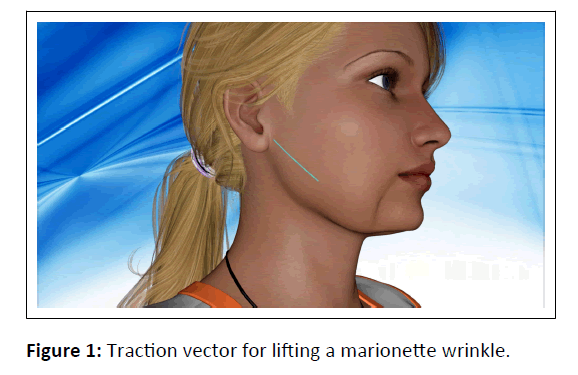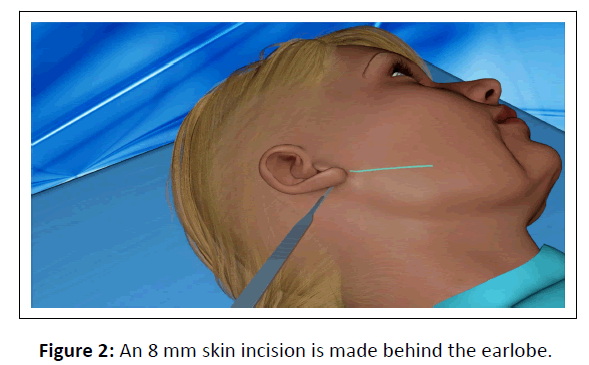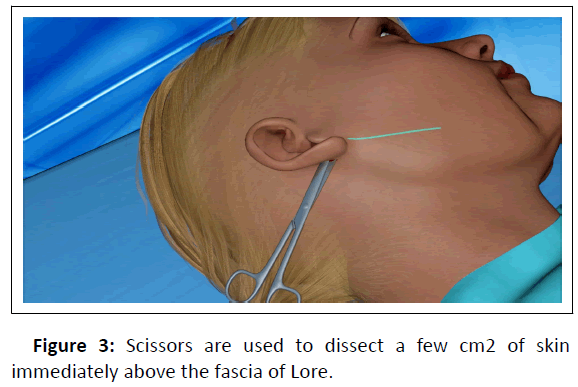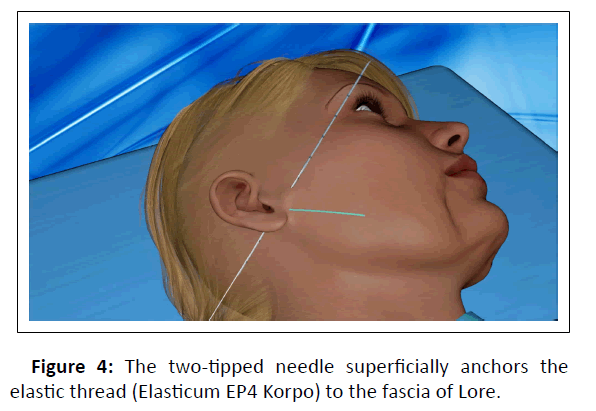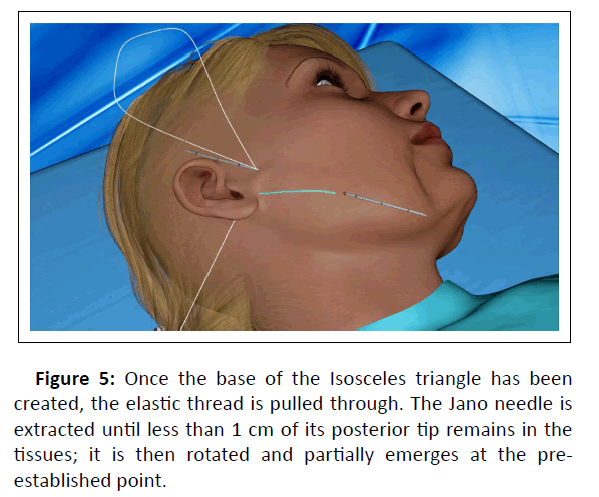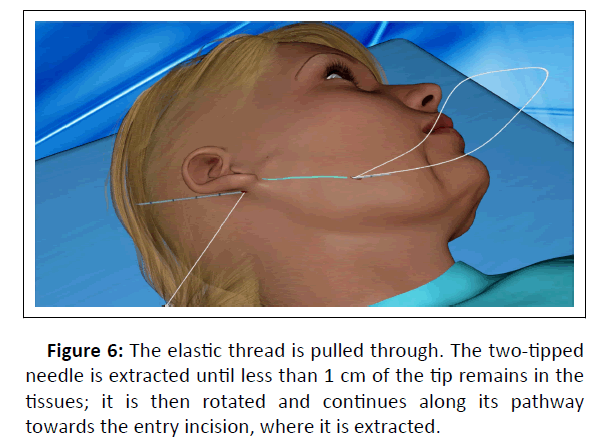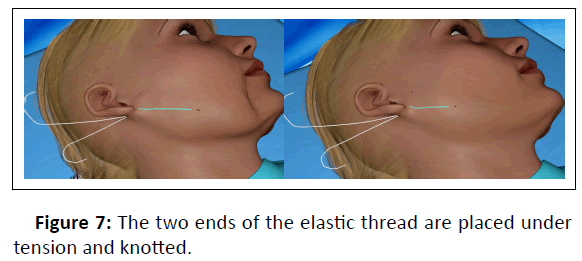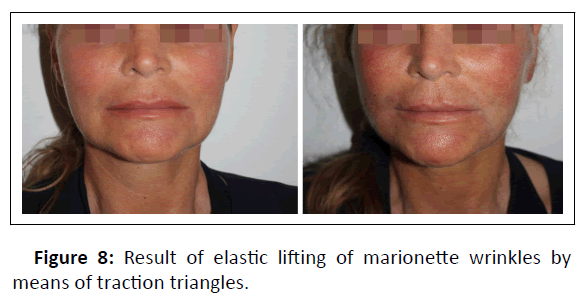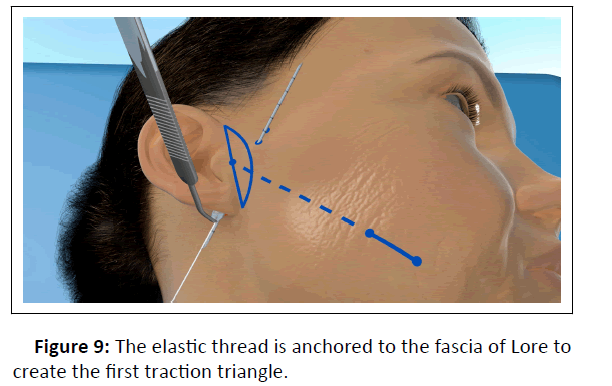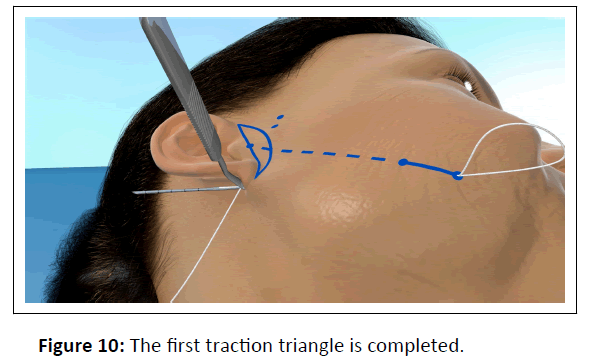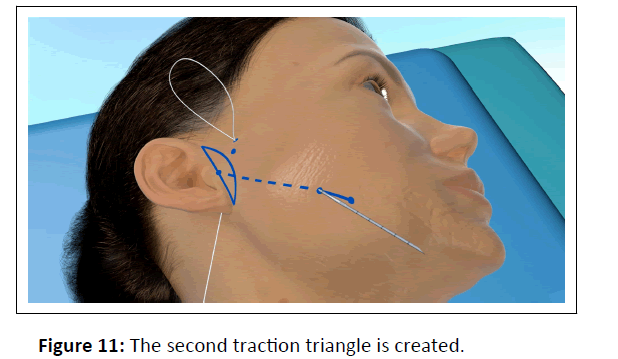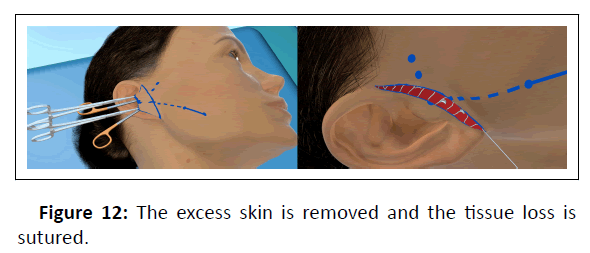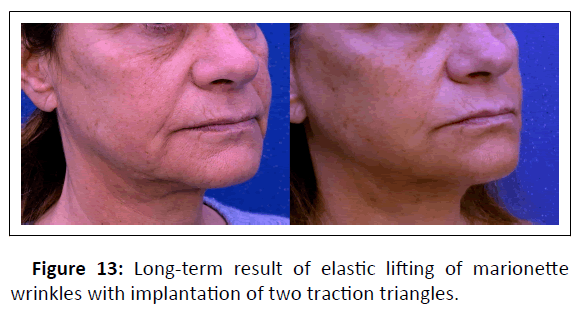Elastic Liftings of Marionette Wrinkles
Sergio Capurro*
Department of Plastic Surgery, Capurro Clinic, Genoa, Italy
- *Corresponding Author:
- Sergio Capurro
Department of Plastic Surgery,
Capurro Clinic, Genoa,
Italy,
E-mail: sergio.capurro@hotmail.it
Received date: August 1, 2022, Manuscript No. IPARS-22-14024; Editor Assigned date: August 3, 2022, PreQC No. IPARS-22-14024 (PQ); Reviewed date: August 15, 2022, QC No. IPARS-22-14024; Revised date: August 25, 2022, Manuscript No. IPARS-22-14024 (R); Published date: September 1, 2022, DOI: 10.4172/2472-1905.8.5.151
Citation: Capurro S (2022) Elastic Liftings of Marionette Wrinkles. J Aesthet Reconstr Surg Vol.8 No.5: 151.
Abstract
Background: Vertical face-lifts correct gravitational ptosis and act on drooping neck skin. When the skin at the sideburns can be pinched between two fingers, we carry out elastic MACS lifting without dissection of the cheeks. Non-absorbable elastic threads mounted on an atraumatic two-tipped needle are used to create three Isosceles triangles: two to lift the cheek and one to lift the malar region; the threads are anchored to the temporal fascia. All the tissues inside the triangles are lifted. The excess temporal skin is dissected up to the zygomatic arch and removed. If the skin at the sideburns cannot be pinched between two fingers, the elastic thread can be implanted through holes made with a 16 G needle.
Once the vertical drooping has been corrected and the face has been made more triangular, the patient may still require lifting by means of oblique traction, to correct marionette wrinkles and better delineate the jaw. One or two Isosceles triangles with the base fixed to the fascia of Lore are used to perform elastic lifting of marionette wrinkles [1].
Methods: The preoperative design is first drawn out. Through an 8 mm skin incision behind the lobe of each ear, a few cm2 of skin above the fascia of Lore is dissected. The two-tipped Jano needle is used to anchor the elastic thread to the fascia, and a triangle is created, which suspends the subcutaneous tissues. If the skin is very slack, two triangles can be created by implanting threads through the same incision behind the earlobe, and the excess preauricular skin is removed. The Elasticum EP3.5 (Korpo) elastic thread is impalpable, does not cut into the tissues and, when colonized by connective cells, becomes an "integrated ligament".
Results: The result is immediately visible and permanent.
Conclusion: Elastic lifting of marionette wrinkles completes vertical elastic lifting of the face. The procedure is efficacious and simple; no skin dissection is needed, and the results are long-lasting.
Keywords
Marionette wrinkles; Elastic suture; Elasticum thread; two tipped-needles; Facial rejuvenation; Marionette lines
Introduction
Patients with evident marionette wrinkles, and who have already undergone lifting of the cheeks, can complete the improvement of the outline of the face through the elastic lifting of their marionette wrinkles, which also delineates the profile of the jaw. The elastic thread mounted on a two-tipped Jano atraumatic needle is used to create one or two Isosceles triangles on each side of the face; the elastic thread that forms the base of the triangle is anchored to the fascia of Lore. These triangles exert traction on the subcutaneous tissues that they enclose. The excess preauricular skin is removed. This simple ambulatory procedure is performed under local anaesthesia.
Materials and Methods
The elastic lifting of marionette wrinkles has been made possible by the invention of a polyester-sheathed silicone thread (Elasticum EP3.5, Korpo) mounted on a two-tipped Jano needle [2-4]. The elastic thread is fixed to the fascia of Lore through an 8 mm incision behind the earlobe. This impalpable elastic thread does not cut into the tissues and once colonized by connective cells, becomes an “integrated ligament”.
Preoperative design
With a finger, the operator exerts traction on the skin, and then marks out the oblique traction vector on each side of the face. The apex of the triangle is situated at a point where lateral traction of the skin causes the defect to disappear. The vector is drawn out up to the fascia of Lore (Figure 1).
If there is an excess of skin, the operator exerts traction on the skin with a finger until the marionette wrinkle disappears. Using another finger, he then marks the point of traction that enables the excess skin to be redistributed in the preauricular region, where it will be removed (Figure 9).
Local anaesthesia
A quantity of 0.5 mg of adrenaline is placed in a 10 ml vial of 2% mepivacaine. The local anaesthetic is injected behind the lobe of the ear where the access incision will be made and into the two preauricular regions above the fascia of Lore. A diluted anaesthetic solution is injected along the pathway of the thread.
Elastic lifting of marionette wrinkles by means of a traction triangle
Once local anaesthesia has been carried out, an 8 mm incision is made behind the lobe of one ear (Figure 2) and the tissues immediately above the fascia of Lore are dissected with scissors (Figure 3).
A spreader is then inserted. The two-tipped needle mounted on the elastic thread is inserted into the cavity, travels beyond the ear and passes tangentially and superficially through the fascia of Lore to create the base of the traction triangle (Figure 4).
The two-tipped needle partially emerges from the preauricular skin, and the elastic thread is pulled through. The operator counts the depth marks on the shaft of the needle. When 1 cm of the posterior tip remains in the tissues, the Jano needle is rotated and moved slightly closer to the surface. It then follows the preoperative design. As the needle travels along its pathway, the operator moves it slightly up and down, to check that no skin introflexions are created. The two-tipped needle partially emerges at the pre-established point of traction at the apex of the triangle (Figure 5).
When about 5 mm of the posterior tip remains in the tissues, the needle is rotated and returns in the direction of the small entry incision, where it is extracted (Figure 6).
As the needle travels along its pathway, the operator checks the depth of implantation, to ensure that the thread is not implanted too deeply and does cause any skin folds to form. The two ends of the elastic thread are placed under tension and knotted (Figure 7).
The traction exerted must not cause major alterations of the morphology of the cheek. The skin incision behind the earlobe is sutured with a rapidly absorbable thread. The result is immediately visible (Figure 8).
Elastic lifting of marionette wrinkles by means of two traction triangles
In patients with marionette wrinkles and excess lateral skin, elastic threads are implanted by means of the two-tipped needle to create two suspension triangles in each side of the face. The excess preauricular skin is removed (Figure 9).
When two Isosceles triangles are implanted, the apex of the first triangle is situated slightly closer to the defect than it is in marionette lifting by means of only one triangle (Figure 10).
The second triangle serves to exert traction on the skin excess that forms as a result of the traction exerted by the first triangle (Figure 11). The excess skin is drawn into the preauricular region, where it is removed.
Once local anaesthesia has been carried out, an 8 mm incision is made behind the earlobe. The tissues immediately above the fascia of Lore are dissected with scissors. A spreader is used to raise the dissected tissues. The two-tipped Jano needle penetrates superficially into the fascia of Lore, anchoring the elastic thread and creating the base of the Isosceles triangle.
The two-tipped needle is partially extracted; it is then rotated and follows the preoperative design. The Jano needle partially emerges at the pre-established point on the design, close to the marionette wrinkle. It then travels along its pathway toward the access incision, where it is extracted. The elastic threads are placed under tension and knotted.
The second triangle is now created; this draws the excess skin into the preauricular region, where it is removed. Removal of the excess skin completes the elastic lifting of marionette wrinkles in patients with slack preauricular skin (Figure 12). The result is permanent (Figure 13).
Results
In the 52 patients treated, the correction of marionette wrinkles and of the profile of the jaw has restored the harmony of the face.
Discussion
Drooping of the skin of the cheeks has a deleterious effect on both the jawline and the neck [5]. We correct the vertical component of this drooping by performing elastic lifting on the medial third of the face [6]; if the tissues at the sideburns can be pinched between two fingers, we carry out elastic MACS lifting [7], which involves dissecting the tissues from the sideburn to the zygomatic arch. After implanting three elastic threads-one to lift the malar region and two to lift the cheeks-we remove the excess temporal skin. The cheeks are not dissected.
Elastic lifting of marionette wrinkles corrects the oblique slackness of the cheeks; if there is an excess of preauricular skin, it is removed.
Normally, patients who undergo elastic lifting of marionette wrinkles have already undergone elastic lifting of the cheeks or elastic MACS lifting, and do not have excess vertical skin.
Through the 8 mm skin incisions behind the earlobes, we can also simultaneously perform elastic neck lifting with one or two elastic threads [8-9] or with three elastic threads and four safety pins. This latter procedure is particularly indicated for patients with more aged necks. As is known, the neck is not dissected; the tissues are simply repositioned. This innovative procedure enables vertical wrinkles and low horizontal wrinkles of the neck to be minimized without causing unnecessary trophic damage to the tissues. These procedures have been made possible by the invention of the two-tipped Jano needle and the Elasticum thread, which is impalpable, does not cut into the tissues, and is transformed into a “ligament”. Facial ageing is due to the longterm effects of gravity on the superficial soft-tissue envelope of the face and neck. The deep tissues are not involved. In our view, all those traumatic procedures that strive to mobilize, lift, and reposition the superficial tissues by acting on the SMAS, the deep fat compartments and the ligaments are outdated [10-12]. This conviction is confirmed by the honest observation of the disappointing results in the medium and long term of neck liftings with full neck undermining, complete platysma transection and midline platysma approximation [13]. The author concludes with this sentence: "After 25 years' experience with these deficiencies, a reconsideration of the most appropriate procedure for correction of the anterior neck is warranted".
Neck lifting is important because it contributes to delineating the profile of the jaw. The elastic thread between the two fasciae of Lore permanently restores the cervicomandibular angle. The excess skin is used to cover the newly formed angle. As the anterior neck skin is suspended by the elastic threads, it does not weigh upon the inferior third of the face.
Correcting the lower part of the face may also require further intervention. For this purpose, we have designed various techniques. For instance, after correcting tissue redundancies, we can restore perioral and mandibular volumes by means of Adipofilling [14] with small lobular fragments. We can also eliminate minor lip wrinkles by means of intradermal cellular Adipofilling [15] or deep lip wrinkles by means of timed surgical mixed peeling [16].
Conclusion
The simple, efficacious Elastic Plastic Surgery procedures described exerts traction close to the defect, spares the subcutaneous tissues and yields long-lasting results.
References
- Capurro S (2015) 3D Elastic lifting of marionette wrinkles. CRPUB Medical Video Journal. Elastic Plastic Surgery section.
- Capurro S (1984) Elastic plastic surgery. Italian Journal of Plastic Surgery 16: 55-58.
- Capurro S (2004) Patent: Sheathed elastic surgical thread. ITGE20030007 (A1): 7-28.
- Capurro S (2016) Patent: Non-traumatic two-tipped needle for surgical suture. BRPI0610496 (A2): 11-16.
- Fedok FG (2019) The rejuvenation of the aged central lower face: A contemporary perspective. Facial Plast Surg 35: 121-128.
[Crossref], [Google Scholar], [Indexing]
- Capurro S (2007) Elastic lifting of the cheeks without blunt dissection. CRPUB Medical Video Journal. Elastic Plastic Surgery section.
- Capurro S (2017) Basic Elastic MACS and Neck Lift without dissection of the cheeks and neck, step-by-step. CRPUB Medical Video Journal. Elastic Plastic Surgery section.
- Capurro S. (2010) Neck lift with two elastic threads. CRPUB Medical Video Journal. Elastic Plastic Surgery section.
- Capurro S (2012) Elastic neck lifting through a 1 cm incision behind the earlobe. CRPUB Medical Video Journal. Elastic Plastic Surgery section.
- Pastorek N, Bustillo A (2005) Deep plane face-lift. Facial Plast Surg Clin North Am 13: 433-449.
[Crossref], [Google Scholar], [Indexing]
- Yang DB, Yang JH, Kim SY (2020) Face lift using dual deep tissue support. J Craniofac Surg 31: 642-647.
[Crossref], [Google Scholar], [Indexing]
- Quatela VC, Jacono AA (2003) The extended centrolateral endoscopic midface lift. Facial Plast Surg 19: 199-208.
[Crossref], [Google Scholar], [Indexing]
- Pelle-Ceravolo M, Angelini M, Silvi E (2016) Complete platysma transection in neck rejuvenation: A critical appraisal. Plast Reconstr Surg 138: 781-791.
[Crossref], [Google Scholar], [Indexing]
- Capurro S (2015) Hypotrophy correction of the lower third of the face with Adipofilling: Adipofilling®. CRPUB Medical Video Journal. Adipofilling section.
- Capurro S (2019) Eliminating lip wrinkles with intradermal cellular Adipofilling. Adipofilling section.
- Capurro S (1998) Permanent removal of wrinkles around the upper lip with timed-surgical mixed peeling. CRPUB Medical Video Journal. Timedsurgery section.
Open Access Journals
- Aquaculture & Veterinary Science
- Chemistry & Chemical Sciences
- Clinical Sciences
- Engineering
- General Science
- Genetics & Molecular Biology
- Health Care & Nursing
- Immunology & Microbiology
- Materials Science
- Mathematics & Physics
- Medical Sciences
- Neurology & Psychiatry
- Oncology & Cancer Science
- Pharmaceutical Sciences
